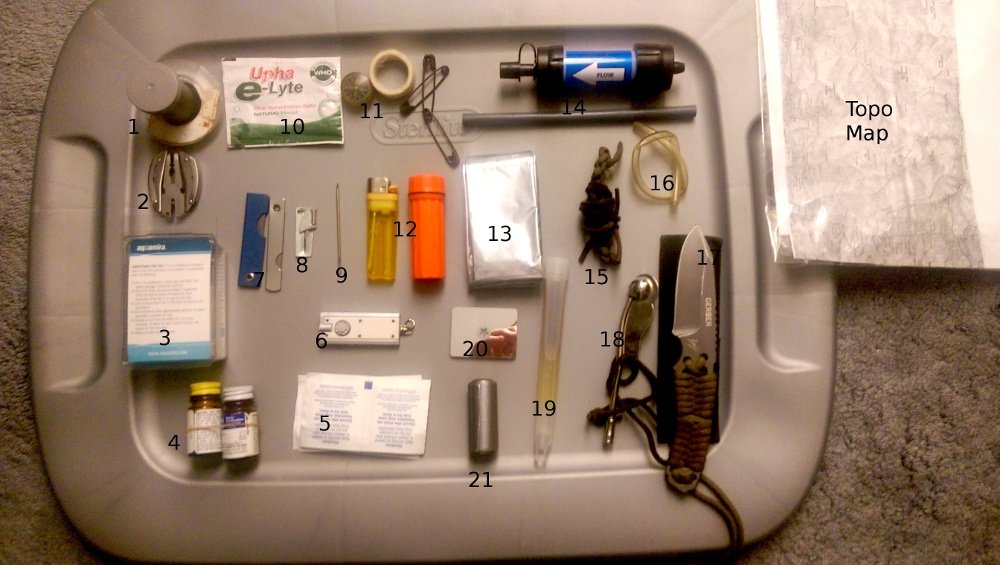I‘ve had a number of readers ask me what I carry for a travel survival kit.
For obvious reasons, my kit has evolved over the years; geography determines a lot of the contents. As always, the objective is to keep everything lightweight and able to fit into the small, waterproof pouch I carry.
These items come from a mix of my own experiences in the jungle, mountains, and islands of Southeast Asia. I’ve included items suggested from survivalists met along the way. For the most part, I’m usually at risk the most in tropical climates, although, in this instance, I’ve packed for a 19-day solo trek in Nepal.
The objective of any travel survival kit should be to increase your odds of surviving an unexpected overnight or longer — and that includes confidence boosters. A big part of surviving is playing the psychological game.
Unlike a lot of the “survival” shows on television, most realistic traveler survival scenarios happen unexpectedly, usually when a small problem spirals out of control and becomes a bigger problem. Many a day hike has turned into a chilly overnight. For instance, your small boat capsizes in Borneo and you end up lost, downriver, and separated from your guide. Or you suffer an injury that prevents you from getting out of the field before dark.
Many cold, unanticipated overnights happened to travelers after sunny day hikes.
Travel Survival Kit Contents
- Fishing Kit: In a film canister, I carry a few hooks of various sizes, a couple of sinkers in case I’m forced to get the line down in a rough sea, and some line. I’ve used the line numerous times to sew backpacks and shoes.
- MultiTool: It’s a lightweight cheapie, but the pliers have come in handy many times. I’ve used the tool to remove stubborn hooks from fish.
- Water Purification: A new addition for this Nepal trip, I’m using AquaMira’s Chlorine Dioxide kit. It can purify up to 30 gallons. Despite the wait time, it can kill viruses.
- Iodine Tablets: My backup water purification solution. They make the water taste terrible, and long-term use isn’t great for the thyroid, but it’s better than dehydration!
- Alcohol Pads: Of course they’re good for disinfecting things, but the main reason I carry a few in this travel survival kit is because they help conserve matches by extending burn time a little. Vaseline on a cotton ball also works as an excellent fire starter, but I haven’t worked out a convenient way to carry the mess.
- LED Light: I certainly wouldn’t trust my life to it, but it weighs nothing and helps me to conserve power on my headtorch if I have to dig around in the kit to find stuff.
- Razor Blades: They’re very lightweight and super sharp.
- Can Opener: An oldie but a goodie from the Army. It also has a hole and could be used as an emergency sinker/reflective spoon to get attention while fishing.
- Big Needle: This can be used for digging out splinters, to sew shoes or leather with the fishing line, and as a makeshift weapon. It’s legal, lightweight, and will certainly make someone who grabbed you let go!
- Electrolytes: I’ve had to administer electrolytes to a traveler on the verge of heatstroke, so I always keep some handy in both my travel survival kit and first-aid kit.
- Compass, Tape, Pins: The compass is just an extra to supplement my larger one in case it is lost.
- Waterproofed Matches: Basic lighter and waterproof matches. I have several pieces of striker paper inside the match container — they’re surprisingly difficult to light. When weight isn’t an issue, I usually carry a magnesium block with striking flint on one side. It was used to start a fire in very wet tinder after getting caught in a winter storm on Mount Rogers — the highest mountain in Virginia.
- Emergency Blanket: They have a number of uses. Although they’re supposed to be for warmth, you can also use them to construct a rapid shelter to prevent severe sunburn in the islands.
- Sawyer Filter: They’re a little bit slow, but it’s a versatile system. While trekking in a National Protected Area in Laos, I used it with the included straw to drink river water after our supply had run out. They filter down to .1 micron absolute, about the best you can get in a filter that size and weight. But that still won’t stop viruses — hence the other treatment options.
- 550 Cord: I carry a braid of Army 550 cord plus some leather lashings for various purposes. Who knows, maybe I can bite on it when getting stitched up by indigenous folks.
- Plastic Tube: When several shipwreck survivors who washed ashore in Indonesia were asked what survival object they wish they had most, many answered a drinking straw! This is because rainwater gets caught in small crevices in tree stumps and volcanic rocks; a tube helps you to reach it easier.
- Survival Knife: I love my Gerber knife. It’s lightweight, simple, has one-piece construction, and can easily be lashed onto a pole for spearfishing. I re-wrapped the 550 cord so that there is a lanyard for diving.
- Boatswain Whistle: Yes, it’s that old whistle they used to blow on a ship to muster everyone. I picked this up at a surplus store and it is the loudest whistle I’ve ever found. Plus, it works when wet.
- Chem Light: Civilians call them “glow sticks.” This is the one we used in the Army; it’s good for 12 hours of emergency light.
- Signal Mirror: It’s lightweight and indestructible. So far, I’ve used it more for shaving than signaling planes.
- Duct Tape: No explanation necessary. Break a pencil and wrap some around it (or wrap it around your lighter).
That’s my current travel survival kit. All of these items fit into a small, waterproof pouch that I toss into my backpack when going to the field. This kit doesn’t include my Black Diamond headlamp and Fenix flashlight that always go along as well.



